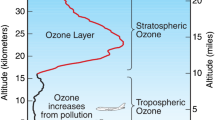Abstract
An overview of the ozone issues is given including the following aspects: 1. The impact of tropospheric ozone on climate as a greenhouse gas (GHG), 2. Solar activity effects on TO and ozone concentration vertical profiles in both the troposphere and stratosphere (in cases of solar radiation absorption by the stratosphere, an unexpected problem arises via a coupling between processes of increased absorption due to “bursts” of solar activity and an enhanced destruction of ozone molecules due to the same increase resulting in weakening UV radiation absorption) and 3. Surface ozone concentration variations under conditions of polluted urban atmospheres which lead to episodes of photochemical smog formation (dangerous for human health).
Similar content being viewed by others
References
Bojkov R. D., Bishop L, Hill W. J., Reinsel G. C. andTiao G. C. (1990): A statistical trend analysis of revised Dobson total ozone data over the Northern hemisphere, J. Geophys. Res., 95, 9785–9807
Effects of Increased Ultraviolet Radiation on Biological Systems (1992): SCOPE/UNEP, Paris, pp. 40
Effects of Increased Ultraviolet Radiation on Global Ecosystems (1993): SCOPE/UNEP, Paris, pp. 47
Ellsaesser H. W. (1994): The unheard arguments: a rational view of stratospheric ozone, 21st Century Science and Technology, 7, 37–45
Fishman J., Ramanathan V., Crutzen P. S. andLiu S. C. (1979): Tropospheric ozone and climate, Nature, 282, 818–820
Ghosh S. and C. Varotsos: On the uptake of O3 into aerosol and water droplets over Athens, Greece, submitted to GRL.
Haigh J. D. (1994): The role of stratospheric ozone in modulating the solar radiative forcing on climate, Nature, 370, 544–546
Impacts of projected depletions of the ozone layer (1995), Consequences, 2, 12–21
Kondratyev K. Ya. (1989): Global Ozone Dynamics, Itogi Nauki I Tekhniki. Geomagnetism and Upper Atmos. Layers, 19, Moscow, VINITI, pp. 212 (in Russian)
Kondratyev K. Ya. (1992): Global Climate, St. Petersburg, Nauka Publ., pp. 359 (in Russian)
Kondratyev K. Ya. (1993): The present state of investigations to assess anthropogenic impacts on ozone. Proc. USSR Acad. Sci. Physics of the Atms. and Ocean, 15, 1235–1251 (in Russian)
Kondratyev K. Ya. andNikolsky G. A. (1995 a): Solar activity and climate. 1 Observation data. Condensation and ozone hypotheses. Studying the Earth from Space, 5, 3–17 (in Russian)
Kondratyev K. Ya. andNikolsky G. A. (1995 b): Solar activity and climate. 2 Direct impact of extraatmospheric spectral distribution variations. Studying the Earth from Space, 6, 3–16 (in Russian)
Kondratyev K. Ya. andVarotsos C. A. (1995): Volcanic eruptions and global ozone dynamics, Int. J. Rem. Sensing, 16, 1887–1895
Kondratyev K. Ya., Varotsos C. A. andCracknell A. P. (1994 a): Total ozone amount trend at St. Petersburg as deduced from Nimbus-7 TOMS observations, Int. J. Remote Sensing, 15, 2669–2677
Kondratyev K. Ya., Varotsos C., Katsambas A., Stratigos G. andAntoniou C. (1994 b): On the risk at human skin from the solar ultraviolet radiation, Doklady of Russian Academic Sciences (RAS), 338, 262–263 (in Russian)
Kondratyev K. Ya., Fedchenko P. P. andVarotsos C. A. (1995 a): Global total ozone dynamics, its impact on surface solar ultraviolet radiation variability and ecosystems, Earth Observation and Remote Sensing (USA), 4, 104–116 (in Russian)
Kondratyev K. Ya., Pokrovsky O. M., Dalyuk I. V. andVarotsos C. A. (1995 b): Atmosphere ozone trends and other factors of surface ultraviolet radiation variability, Environmental Conservation, 6, 17–22
Madronich S. (1992): Implications of recent total atmospheric ozone measurements for biologically active radiation reaching the earth’s surface. Geophys. Res. Lett., 19, 34–40
Michaels P. J., Singer S. E., Knapperberger P. C., Kerr J. B. andMcei-roy C. T. (1994), Analyzing ukraviolet-B radiation: is there a trend?, Science, 264, 1341–1343
Ozone Assessment: Ozone shown to be in continuing decline (1995) World Climate News, 6, pp. 10
Rasch P. J., Boville B. A. andBrasseur G. P. (1995): A three-dimensional general circulation model with coupled chemistry for the middle atmosphere, J. Geophys. Res., 100, 5041–5071
Simon N. (1994): Dose-responsive functions and the health impacts of air pollution, Dissemination Notes. Environment. The World Bank, 11, 1–2
Sklyarov Yu. A. (1994): Solar constant (the state of research). Studying the Earth from Space, 4, 56–110 (in Russian)
Solomon S. andAlbritton D. L. (1992): Time-dependent ozone depletion potentials for short — and long-term forecasts. Nature (Gr. Brit.), 357, 33–37
UNEP (1994): Environmental effects of ozone depletion
Varotsos C. andKondratyev K. Ya. (1994 a): Mean zonal temperature field in the global middle atmosphere and its periodicity. Earth Observation and Remote Sensing, 2, 3–13 (in Russian)
Varotsos C. andKondratyev K. Ya. (1994 b): Solar ultraviolet radiation changes at the Earth’s surface level due to ozone content variations in the troposphere and stratosphere. Studying the Earth from Space, 1, 3–10 (in Russian)
Varotsos C. andKondratyev K. Ya. (1995 a): On underestimation of total ozone content values for the region of Athens (Greece) obtained from satellite measurement data. Doklady of Russian Acad. Sci. (RAS), 340, 247–249 (in Russian)
Varotsos C. andKondratyev K. Ya. (1995 b): The tropospheric pollution and ultraviolet solar radiation Optics of the Atmosphere and Ocean 8, 4, 614–618 (in Russian)
Wang W.-Chu andIsaksen I. S. A. (Eds.) (1995): Atmospheric Ozone as a Climatic Gas, General Circulation Model Simulations NATO ASI Ser. I: Global Environmental Change, 32, Springer, Berlin e. a., pp. 461
Author information
Authors and Affiliations
Additional information
An erratum to this article is available at http://dx.doi.org/10.1007/BF02986281.
Rights and permissions
About this article
Cite this article
Kondratyev, K.Y., Varotsos, C.A. Global total ozone dynamics. Environ. Sci. & Pollut. Res. 3, 153–157 (1996). https://doi.org/10.1007/BF02985523
Issue Date:
DOI: https://doi.org/10.1007/BF02985523




